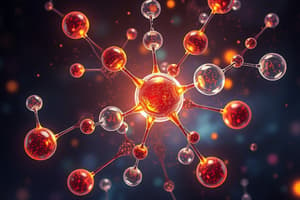Podcast
Questions and Answers
What contributes to the stability of ATP compared to its hydrolysis products?
What contributes to the stability of ATP compared to its hydrolysis products?
- ATP has a higher molecular weight than ADP
- High concentration of ATP outside the cell
- Presence of Mg2+ which shields negative charges in the molecule (correct)
- ATP molecules form strong covalent bonds with water
Which reaction has the largest free energy change?
Which reaction has the largest free energy change?
- Glu + P → Glu-6P
- Glu + P + ATP → Glu-6P + ADP + P
- Glu + ATP → Glu-6P + ADP (correct)
- ATP → ADP + P
ATP is considered a high-energy compound primarily because it can:
ATP is considered a high-energy compound primarily because it can:
- Donate phosphates to compounds with higher energy levels
- Keep ATP levels constant in all conditions
- Provide energy through group transfers (correct)
- Undergo simple hydrolysis to release energy
What is the role of kinases in biochemical reactions involving ATP?
What is the role of kinases in biochemical reactions involving ATP?
Which of the following processes requires energy derived from ATP?
Which of the following processes requires energy derived from ATP?
What is the consequence of ATP hydrolysis in cellular processes?
What is the consequence of ATP hydrolysis in cellular processes?
What type of group can ATP donate to other molecules?
What type of group can ATP donate to other molecules?
What is the standard free energy change (∆G) for the hydrolysis of ATP to ADP?
What is the standard free energy change (∆G) for the hydrolysis of ATP to ADP?
What is the Gibbs free energy change ($ riangle G$) associated with breaking phosphoanhydrides of nucleoside triphosphates (NTPs)?
What is the Gibbs free energy change ($ riangle G$) associated with breaking phosphoanhydrides of nucleoside triphosphates (NTPs)?
What is the role of nucleoside diphosphate kinase in energy transfer?
What is the role of nucleoside diphosphate kinase in energy transfer?
In biological oxidation-reduction reactions, what does the acronym LEO stand for?
In biological oxidation-reduction reactions, what does the acronym LEO stand for?
What is the primary effect of reduction in biological systems?
What is the primary effect of reduction in biological systems?
What does dehydrogenation in biochemical substrates signify?
What does dehydrogenation in biochemical substrates signify?
Which of the following statements is true regarding redox pairs?
Which of the following statements is true regarding redox pairs?
Which cofactor is commonly involved in the transfer of protons and electrons during oxidation?
Which cofactor is commonly involved in the transfer of protons and electrons during oxidation?
What is the ΔG' for the reaction catalyzed by creatine kinase?
What is the ΔG' for the reaction catalyzed by creatine kinase?
What is the main characteristic of isomerisation reactions?
What is the main characteristic of isomerisation reactions?
What role do inorganic phosphate groups play in biochemical reactions?
What role do inorganic phosphate groups play in biochemical reactions?
How is the equilibrium constant (Keq) defined in terms of the forward and reverse reactions?
How is the equilibrium constant (Keq) defined in terms of the forward and reverse reactions?
What does the standard free-energy change (ΔG0) indicate about a biochemical pathway?
What does the standard free-energy change (ΔG0) indicate about a biochemical pathway?
What is a key property of ATP hydrolysis in biochemical reactions?
What is a key property of ATP hydrolysis in biochemical reactions?
What does the relationship ΔG0 = -RT ln Keq represent?
What does the relationship ΔG0 = -RT ln Keq represent?
Which factor contributes to ATP's tendency to lose its terminal phosphate group?
Which factor contributes to ATP's tendency to lose its terminal phosphate group?
In group transfer reactions, which of the following is a common nucleophile?
In group transfer reactions, which of the following is a common nucleophile?
Which statement about phosphoryl transfer is correct?
Which statement about phosphoryl transfer is correct?
Why is the tetrahedral structure of (orto)phosphate significant?
Why is the tetrahedral structure of (orto)phosphate significant?
What vitamin deficiency is associated with Pellagra?
What vitamin deficiency is associated with Pellagra?
Which of the following symptoms is NOT associated with Pellagra?
Which of the following symptoms is NOT associated with Pellagra?
What is the primary role of NAD+/NADH in metabolism?
What is the primary role of NAD+/NADH in metabolism?
Which vitamin is linked to the FAD/FADH2 redox system?
Which vitamin is linked to the FAD/FADH2 redox system?
What class of chemical reactions is responsible for breaking C-C bonds?
What class of chemical reactions is responsible for breaking C-C bonds?
Which of the following diseases is primarily associated with a deficiency in riboflavin?
Which of the following diseases is primarily associated with a deficiency in riboflavin?
In terms of thermodynamics, what does ΔG signify in biochemical reactions?
In terms of thermodynamics, what does ΔG signify in biochemical reactions?
What is the consequence of a deficiency in niacin?
What is the consequence of a deficiency in niacin?
What does a more positive standard reduction potential (E'o) indicate about an oxidizing agent?
What does a more positive standard reduction potential (E'o) indicate about an oxidizing agent?
What occurs when the Gibbs free energy change (ΔG) is less than zero?
What occurs when the Gibbs free energy change (ΔG) is less than zero?
If the standard reduction potential of a redox pair is -0.42 V, what does this imply about its behavior?
If the standard reduction potential of a redox pair is -0.42 V, what does this imply about its behavior?
What is the relationship between ΔE'o and the change in free energy (ΔG) in a spontaneous reaction?
What is the relationship between ΔE'o and the change in free energy (ΔG) in a spontaneous reaction?
Which of the following redox pairs has the most positive standard reduction potential?
Which of the following redox pairs has the most positive standard reduction potential?
What effect does a more negative E'o have on a species involved in a redox reaction?
What effect does a more negative E'o have on a species involved in a redox reaction?
In the redox reaction involving NADH and FMN, what is the consequence of the oxidation of NADH?
In the redox reaction involving NADH and FMN, what is the consequence of the oxidation of NADH?
What is one factor that must be true for ΔG to be negative in a redox reaction?
What is one factor that must be true for ΔG to be negative in a redox reaction?
Flashcards are hidden until you start studying
Study Notes
Isomerization and Elimination Reactions
- Isomerization reactions involve the rearrangement of atoms within a molecule, resulting in the formation of an isomer.
- Elimination reactions involve the removal of atoms or groups from a molecule, leading to the formation of a double or triple bond.
Group Transfer Reactions
- Group Transfer Reactions involve the transfer of a chemical group from one molecule to another.
- Examples of groups transferred include acyl, glycosyl and phosphoryl.
- These reactions are classified as nucleophilic substitutions.
Inorganic Phosphate Groups in Biochemical Reactions
- These groups act as leaving groups during reactions.
- Orthophosphate has a tetrahedral structure similar to that of water.
- Pyrophosphate can also act as a leaving group in biochemical reactions.
Bioenergetics and Thermodynamics
- The equilibrium constant (Keq) measures the ratio of products to reactants at equilibrium.
- The standard free-energy change (ΔG°) is related to the equilibrium constant by the equation: ΔG° = -RTlnKeq.
- This equation indicates that a negative ΔG° favors the formation of products.
Consecutive Reactions - Biochemical Pathways
- The free energy changes in a biochemical pathway are additive.
- If the sum of ΔG values is negative, the pathway is favorable and proceeds in the forward direction.
- ATP hydrolysis is a highly exergonic process (ΔG° is significantly negative).
- This is why ATP is used in many phosphorylating reactions instead of direct phosphate transfer.
Chemical Versatility of ATP
- ATP can donate phosphoryl, pyrophosphoryl, or adenylyl groups.
- The position of nucleophilic attack can be determined by 18O labeling.
Redox Pairs
- Oxidation-reduction reactions always occur in pairs.
- Standard reduction potential (E°') quantifies the tendency of a molecule to gain electrons, with a more positive E°' indicating a stronger oxidizing agent.
- The change in free energy (ΔG°) is directly related to the change in standard reduction potential (ΔE°').
- The relationship between ΔG° and ΔE°' is: ΔG° = -nFE°', where n is the number of electrons transferred, F is Faraday's constant, and ΔE°' is the change in standard reduction potential.
- The ΔE°' must be positive for the reaction to proceed spontaneously.
NAD+/NADH Redox System
- NAD+ is an important cofactor for dehydrogenase enzymes.
- NADH is the reduced form of NAD+.
- Niacin deficiency leads to pellagra, characterized by dermatitis, dementia, and diarrhea.
FAD/FADH2 Redox System
- FAD is another important cofactor for dehydrogenase enzymes.
- FADH2 is the reduced form of FAD.
- Riboflavin (vitamin B2) deficiency causes ariboflavinosis.
- Symptoms include angular cheilitis, itchy eyes, light sensitivity, dermatitis, and anemia.
Diseases and Drugs
- Pellagra is a disease caused by niacin deficiency.
- Ariboflavinosis is a disease caused by riboflavin deficiency.
- Niacin and riboflavin are essential vitamins that can be consumed in the diet to prevent these deficiencies.
Studying That Suits You
Use AI to generate personalized quizzes and flashcards to suit your learning preferences.




